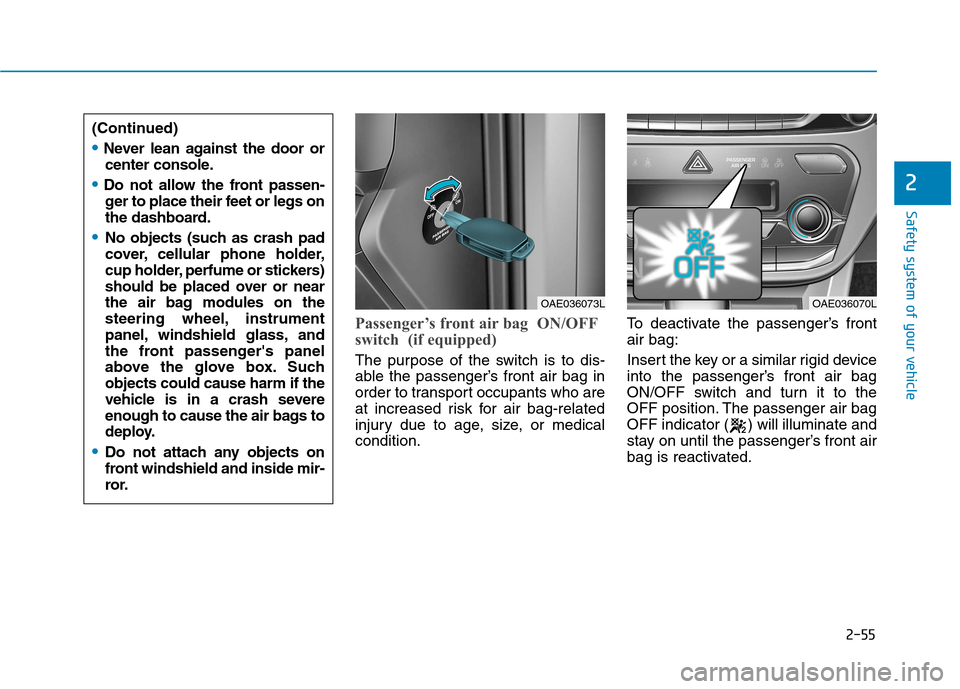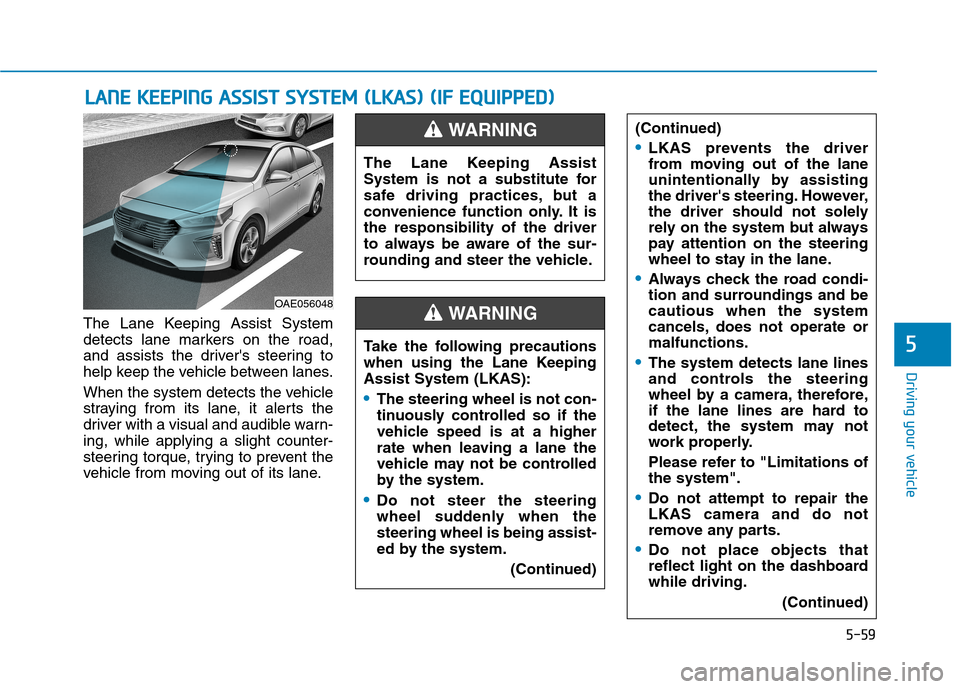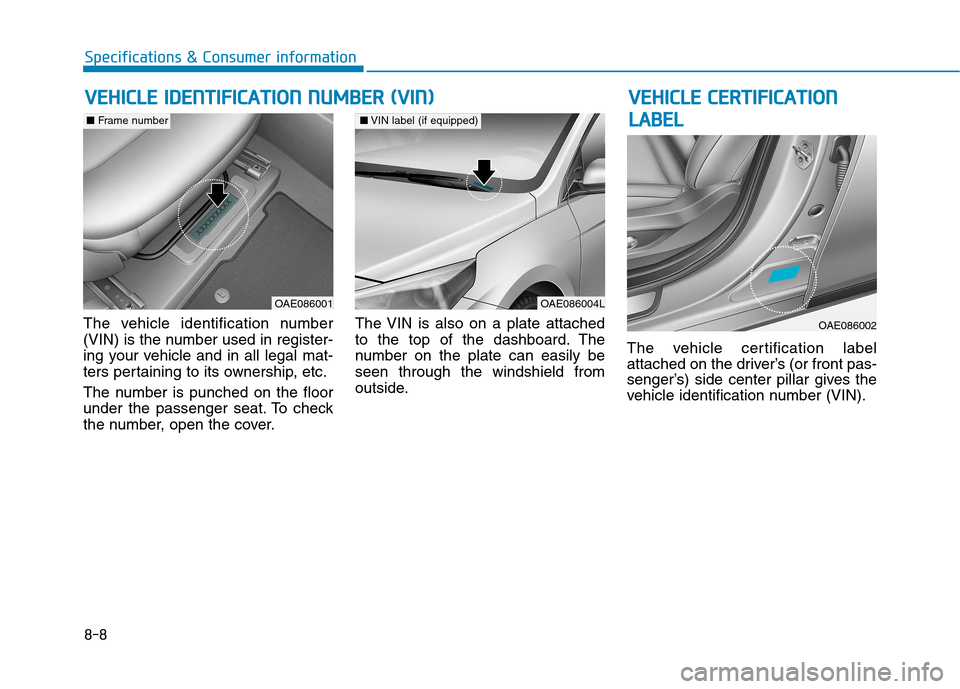2017 Hyundai Ioniq Hybrid dashboard
[x] Cancel search: dashboardPage 36 of 553

2-6
Safety system of your vehicle
To reduce the risk of serious
injury or death from an inflating
air bag, take the following pre-cautions:
•Adjust the driver’s seat as far
to the rear as possible main-
taining the ability to control of
the vehicle.
Adjust the front passenger seat
as far to the rear as possible.(Continued)
WARNING
(Continued)
Hold the steering wheel by the
rim with hands at the 9 o’clock
and 3 o’clock positions to min-
imize the risk of injuries to
your hands and arms.
NEVER place anything or any-
one between the air bag.
Do not allow the front passen-
ger to place feet or legs on the
dashboard to minimize the riskof leg injuries.
Safety precautions
Adjusting the seats so that you are sit-
ting in a safe, comfortable position
plays an important role in driver and
passenger safety together with theseat belts and air bags in an accident.
Air bags
You can take steps to reduce the risk
of being injured by an inflating air
bag. Sitting too close to an air bag
greatly increases the risk of injury in
the event the air bag inflates. Move
your seat as far back as possible
from front air bags, while still main-
taining control of the vehicle.
Do not use a cushion that reduces
friction between the seat and the
passenger. The passenger's hips
may slide under the lap portionof the seat belt during an acci-
dent or a sudden stop. Serious or fatal internal injuries could result because the seat
belt cannot operate properly.
WARNING
Page 85 of 553

2-55
Safety system of your vehicle
2
Passenger’s front air bag ON/OFF
switch (if equipped)
The purpose of the switch is to dis-
able the passenger’s front air bag in
order to transport occupants who are
at increased risk for air bag-related
injury due to age, size, or medicalcondition.To deactivate the passenger’s frontair bag:
Insert the key or a similar rigid device
into the passenger’s front air bag
ON/OFF switch and turn it to the
OFF position. The passenger air bag
OFF indicator ( ) will illuminate and
stay on until the passenger’s front air
bag is reactivated.
OAE036073LOAE036070L
(Continued)
Never lean against the door or
center console.
Do not allow the front passen-ger to place their feet or legs on
the dashboard.
No objects (such as crash pad
cover, cellular phone holder,
cup holder, perfume or stickers)
should be placed over or near
the air bag modules on the
steering wheel, instrument
panel, windshield glass, and
the front passenger's panel
above the glove box. Suchobjects could cause harm if the
vehicle is in a crash severe
enough to cause the air bags to
deploy.
Do not attach any objects on
front windshield and inside mir-
ror.
Page 343 of 553

5-59
Driving your vehicle
The Lane Keeping Assist System
detects lane markers on the road,
and assists the driver's steering to
help keep the vehicle between lanes.
When the system detects the vehicle
straying from its lane, it alerts the
driver with a visual and audible warn-ing, while applying a slight counter-
steering torque, trying to prevent the
vehicle from moving out of its lane.
LLAA NN EE KK EEEE PP IINN GG AA SSSSIISS TT SS YY SSTT EEMM (( LL KK AA SS)) (( IIFF EE QQ UUIIPP PPEEDD ))
5
OAE056048 The Lane Keeping Assist
System is not a substitute for
safe driving practices, but a
convenience function only. It isthe responsibility of the driver
to always be aware of the sur-
rounding and steer the vehicle.
WARNING
Take the following precautions
when using the Lane KeepingAssist System (LKAS):
The steering wheel is not con-
tinuously controlled so if the
vehicle speed is at a higher
rate when leaving a lane the
vehicle may not be controlled
by the system.
Do not steer the steering
wheel suddenly when thesteering wheel is being assist-
ed by the system.
(Continued)
(Continued)
LKAS prevents the driver
from moving out of the lane
unintentionally by assisting
the driver's steering. However,
the driver should not solely
rely on the system but always
pay attention on the steering
wheel to stay in the lane.
Always check the road condi-
tion and surroundings and becautious when the system
cancels, does not operate ormalfunctions.
The system detects lane lines
and controls the steering
wheel by a camera, therefore,
if the lane lines are hard to
detect, the system may not
work properly.
Please refer to "Limitations of the system".
Do not attempt to repair the LKAS camera and do not
remove any parts.
Do not place objects that
reflect light on the dashboardwhile driving.
(Continued)
WARNING
Page 522 of 553

8-8
Specifications & Consumer information
The vehicle identification number
(VIN) is the number used in register-
ing your vehicle and in all legal mat-
ters pertaining to its ownership, etc.
The number is punched on the floor
under the passenger seat. To check
the number, open the cover.The VIN is also on a plate attached
to the top of the dashboard. The
number on the plate can easily beseen through the windshield from
outside.
The vehicle certification label
attached on the driver’s (or front pas-
senger’s) side center pillar gives the
vehicle identification number (VIN).
VV
EEHH IICC LLEE IIDD EENN TTIIFF IICC AA TTIIOO NN NN UU MM BBEERR (( VV IINN )) VVEEHH IICC LLEE CC EE RR TTIIFF IICC AA TTIIOO NN
L
L AA BBEELL
OAE086004L
■VIN label (if equipped)
OAE086001
■ Frame number
OAE086002
Page 545 of 553

I-4ISOFIX anchorage and top-tether anchorage
for children ..............................................................2-42
Rearward-facing child restraint system .....................2-39
Securing a child restraint system seat with "Top-tether Anchorage" system ...............................3-44
Securing a child restraint system with a lap/shoulder belt....................................................3-46
Securing a child restraint system with the "ISOFIX Anchorage System" ............................2-43
Child-protector rear door lock ...................................3-16
Cigarette lighter ..........................................................3-137
Clean air......................................................................3-129
Climate control air filter ...............................................7-32
Clock ...........................................................................3-137
Clothes hanger ............................................................3-138
Combined instrument, see instrument cluster ..............3-42
Compact spare tire replacement ...................................7-46
Coolant..........................................................................7-24
Cooling fluid, see engine coolant/inverter coolant ......7-24
Crankcase emission control system..............................7-90
Cruise control system ...................................................5-69
Cup holder ..................................................................3-132
Curtain air bags.............................................................2-58
Dashboard illumination, see instrument panel illumination.................................................................3-43
Dashboard, see instrument cluster ................................3-42 Day/night rearview mirror ............................................3-23
Daytime running light (DRL) .......................................3-95
Defogging (Windshield) .............................................3-116
Defroster .....................................................................3-111
Rear window defroster .............................................3-111
Defrosting (Windshield) .............................................3-116
Dimensions .....................................................................8-2
Display illumination, see instrument panel illumination.................................................................3-43
Displays, see instrument cluster ...................................3-42
Distance to empty (for cluster type B) .........................3-48
Door locks.....................................................................3-12 Auto door lock/unlock features .................................3-16
Central door lock switch ............................................3-14
Child-protector rear door lock ...................................3-16
Drinks holders, see cup holders..................................3-132
Driver position memory system ...................................3-18 Recalling memory positions ......................................3-19
Storing memory positions ..........................................3-18
Driver's air bag .............................................................2-54
Driver's knee air bag .....................................................2-54
Driving at night.............................................................5-93
Driving in flooded areas ...............................................5-94
Driving in the rain ........................................................5-93
Dual clutch transmission ..............................................5-15 Good driving practices...............................................5-23
Manual shift mode .....................................................5-21
Shift lock system .......................................................5-22
Dual clutch transmission shift indicator .......................3-49
Index
D